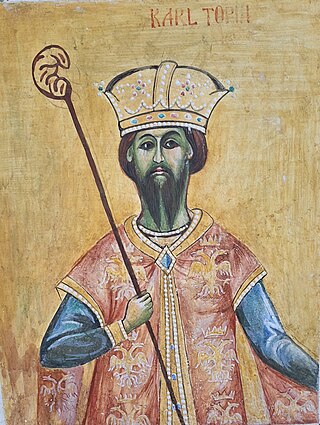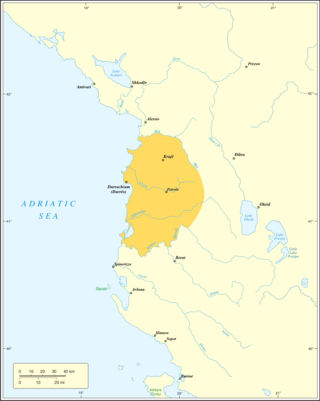
Robert of Anjou, known as Robert the Wise, was King of Naples, titular King of Jerusalem and Count of Provence and Forcalquier from 1309 to 1343, the central figure of Italian politics of his time. He was the third son of King Charles II of Naples and Mary of Hungary, and during his father's lifetime he was styled Duke of Calabria (1296–1309).

Karl Thopia was an Albanian feudal prince and warlord who ruled Albanian domains from 1358 until the first Ottoman conquest of Albania in 1388. Thopia usually maintained good relations with the Roman Curia.

Gjergj Thopia, also known as Giorgio, Georg or George was an Albanian Prince and member of the Thopia family. He was the Prince of Albania and the Lord of Durrës from 1388 to 1392. His reign was marked by efforts to maintain control of his territories amidst increasing Ottoman pressure and internal rivalries with other Albanian noble families. Gjergj allied with Venice to protect Durrës but ultimately relinquished the city to Venetian rule due to declining health and political instability. Gjergj's death in 1392 marked the end of his lineage, with his holdings passing to his sister, Helena Thopia, and his legacy shaped by his alliances and resistance to Ottoman encroachment.
The Battle of Savra or the Battle of the Vjosë was fought on 18 September 1385 between Ottoman and much smaller Zetan forces, at the Savra field near Lushnjë. The Ottomans were invited by Karl Thopia to support him in his feud against Balsha II.

Hélène of Anjou, was a member of the House of Anjou. She was an illegitimate daughter of Robert, King of Naples.

The Principality of Albania was an Albanian principality ruled by the Albanian dynasty of Thopia. The first notable ruler was Tanusio Thopia, who became Count of Mat in 1328. The principality would reach its zenith during the rule of Karl Thopia, who emerged in 1359 after the Battle of Achelous, conquering the cities of Durrës and Krujë and consolidating his rule of central Albania between the rivers of Mat and Shkumbin. The principality would last up until 1415, when it was conquered by the Ottoman Empire.

The Muzaka family was an noble Albanian family that ruled over the region of Myzeqe in the Late Middle Ages. The Muzaka are also referred to by some authors as a tribe or a clan. The earliest historical document that mentions the Muzaka family is written by the Byzantine historian Anna Komnene. At the end of the 13th and beginning of the 14th century members of the Muzaka family controlled a region between the rivers of Devoll and Vjosë. Some of them were loyal to the Byzantine Empire while some of them allied with Charles of Anjou who gave them impressive Byzantine-like titles in order to subdue them more easily. In the 1340s, Stefan Dušan pressed further south into Albania, and by 1343-45 had taken central towns and territories in southern Albania, including domains of the Muzaka family. However, they would fall back under local control after his death in 1355. After the Battle of Savra in 1385 the territory of Albania came under the Ottoman Empire; they served the Ottomans until 1444 when Theodor Corona Musachi joined Skanderbeg's rebellion. When the Ottomans suppressed Skanderbeg's rebellion and captured the territory of Venetian Albania in the 15th century many members of the Muzaka family retreated to Italy. Those who stayed in Ottoman Albania lost their feudal rights, some converted to Islam and achieved high ranks in the Ottoman military and administrative hierarchy.

Teodor II Muzaka, was an Albanian Prince from the House of Muzaka, he was the Lord of Berat and Lord of Myzeqe.

Teodor I Muzaka was an Albanian nobleman that ruled the Lordship of Berat between 1319 and 1331. According to John Musachi, he had the nickname "këshetesi", meaning the one with braided hair. He had a brother Count Mentula Muzaka of Clissura or today called Kelcyra.

The Thopia were one of the most powerful Albanian feudal families in the Late Middle Ages, part of the nobility of the Angevin Kingdom of Albania.
Andrea II Thopia was a 15th century Albanian nobleman whose domains included the territory of Scuria. He was a member of the Thopia family and one of the founders of the League of Lezhë.

Tanusio Thopia or Tanush Thopia was an Albanian count that served Princes of Taranto Philip I and Robert, and Dukes of Durazzo John and Charles. He had domains in Mat.

Andrea II Muzaka was an Albanian nobleman of the Muzaka family and the ruler of the Principality of Muzaka in the 14th century. He inherited the principality from his father, Teodor I Muzaka, who died around 1331. Andrea II is known for having expanded the Principality of Muzaka to its greatest extent, from the southern Adriatic coastline of Albania in the west to Kastoria in the east by the time of his death in 1372.

Chiranna Zenevisi, also known as Anna was an Albanian noblewoman and member of the Zenevisi family, as the daughter of Count John Zenevisi.

Lady Maria Thopia was a 14th-15th century Albanian noblewoman and a recognised illegitimate daughter of Karl Thopia, Prince of Albania, by an unknown mistress. She married Filippo Maramonte, 1st Baron of Botrugno, chancellor and marshal of Ladislaus of Naples.

Gjin I Muzaka, was an Albanian Prince from the House of Muzaka. He held the majority of his father's holdings after his father's death and was the Lord of Tomorniza. As well as the Lord of Kastoria after his younger brother Stoya Muzaka died after 1384 leaving no heirs.

Euphemia Mataranga, also known as Euthymia, Eythvmia, Etinia or Onorata was an Albanian noblewoman and member of the Mataranga family.

Chiranna Muzaka, also known as Kyranna or Anne was an Albanian princess and member of the Muzaka family.

Voisava Balšić, also known as Vojislava, Vojsava or Voislava was an Albanian princess and member of the Balsha family.

Paul Mataranga, also known as Paul Matarango or Paolo Matarango was an Albanian Lord and member of the Mataranga family.














